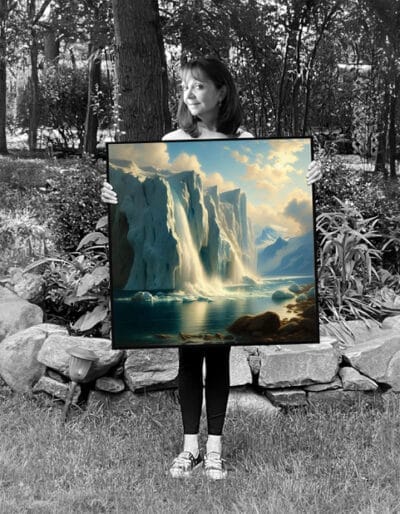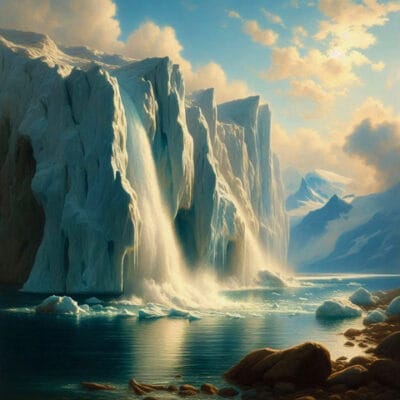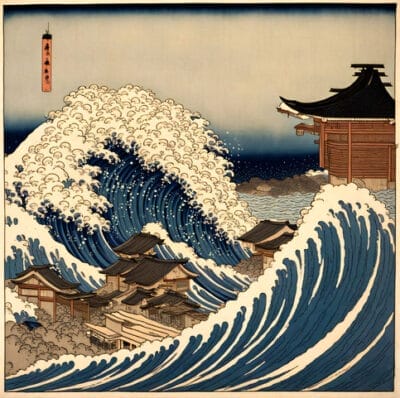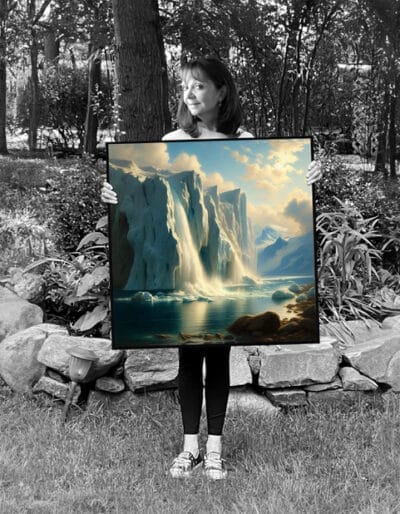
Selva Ozelli interviews Mary Tiegreen about her environmentally inspired paintings.
Tell us about your educational and professional background as an artist
My interest in art began early and led me to earn a Bachelor of Fine Arts at the University of Iowa. I went on to study art in London and New York which resulted in a career in graphic design and the publishing industry. Throughout my career, I always had a fascination with technology as a tool for creation and was a very early adopter of the Macintosh computer for use in my design studio.
London Climate Action week featuring Mary Tiegreen
How did you become interested in environmental issues as a photographer and an AI artist?
My childhood summers were spent in a cottage on a pristine lake in Northern Michigan. It was here that I first connected with nature in a deep and thoughtful way, the way a child becomes a part of the nature around her. The clear cold waters of Lake Superior and the tall pine forests. Chipmunks and porcupines, and the occasional black bear lumbering down the path. A family of eagles high in a white pine tree. A Rainbow Trout breaking the surface of the lake. Wild blueberry bushes everywhere. The Northern Lights reflected in the water. And the beautiful silence when walking in our forest.
As the world has grown crowded and the climate continues to heat up, I have been heartsick at the thought of these treasures I cherished being destroyed. I wanted to contribute in some way to help change the direction we are all headed.
Tell us about your “Climate Disasters Inspired by Great Masters” (“AI Art Series”) that is on exhibit at the Lamont-Doherty Earth Observatory of Columbia University from October 1, 2024 to October 31, 2026.
Over the past eight years, I have had the opportunity to work as art director on ClimateChangeResources.org, an extensive not-for profit website dedicated to climate change issues. In early 2023, while working on ideas to illustrate sea level rise on the website, I began to wonder what New York City might look like under ten feet of water if painted by an artist. I’d been exploring Bing’s AI text-to-image creator for a while and thought this could be an interesting test of the medium. Included in my prompt was a request for AI to paint this image of sea level rise in New York City in the style of James McNeill Whistler.
In less than 30 seconds, I was staring at an image that seemed to have been painted by this artist from a distant past, depicting an environmental crisis from the future. And that was how this project began.
I worked closely with Lena Tabori, one of the founders of the site. We collaborated on the choices of the climate issues and possible artists, and Lena wrote the text descriptions.
The website presents 36 climate disasters, each inspired by a different famous artist, along with a short description of the issues surrounding this specific disaster as well as a link to a page that offers an in-depth look at the problem.
How many issues caused by global warming does your AI Art Series address; why did you choose AI Art as opposed to photography to articulate these issues; and why did you pick each master artist to articulate those issues?
While the Climate Change Resources web site has 36 images, the exhibition at Lamont has 29 canvases, due to limited space.
Once I saw the possibilities of the AI images, I never thought about another medium. Photography is a very powerful resource to engage people, and there is a lot of incredible work out in the world today. I felt that I could contribute more by working with AI to create evocative and serious images that connect to the hearts of viewers.
Matching the artists to the subjects was sometimes a very clear decision, and sometimes serendipity. There were some issues that we tried three or four different artists before finding the one. And other were one and done.

Melting Glaciers
Some Say the World Will End In Fire, Some Say In Ice
Inspired by the work of Alfred Bierstadt
Melting glaciers and ice sheets in Greenland and Antarctica have a direct and profound impact on sea-level rise which, in turn increases coastal erosion and elevates storm surge as warming air and ocean temperatures create more frequent and intense coastal storms like hurricanes and typhoons.
NASA reports that Antarctica is losing about 150 billion tons of ice mass per year, and Greenland is losing about 270 billion tons per year.
This phenomenon is not limited to the poles and is happening around the world, including the U.S.
For more information on this subject go to this CCR page Melting Ice & Snow
EXTINCTION
Alas, My Friends, How Foolish We Were
Inspired by the work of Hieronymus Bosch
Climate change has transformed and degraded habitats and ecosystems —the places where animals have spent millions of years adapting.
According to a UN report on biodiversity, one million animals and plants face extinction due to climate change.
Earth’s wildlife population has fallen on average by a “catastrophic” rate of 73% in the past half-century. In the ocean, rising temperatures increase the risk of irreversible loss of marine and coastal ecosystems. Since 1900, nearly 3 species of seed-bearing plants have disappeared per year ? 500 times faster than they would naturally.
This risk of overwhelming extinction increases with every degree of warming.
For more information on this subject go to this CCR page Extinction

SEA LEVEL RISE
The ocean once protected us
Inspired by the work of Katsushika Hokusai
Almost three-quarters of Earth’s surface is covered by oceans. Another 10% is covered by ice sheets and glaciers. The warming of Earth is primarily due to accumulation of heat-trapping greenhouse gases, and more than 90% of this trapped heat is absorbed by the oceans.
As the water warms, it expands: about half of the sea level rise over the past twenty five years is attributable to warmer oceans. The ocean is rising at a current rate of about one inch every 8 years.
The consequences are staggering, intensifying flooding, erosion and hurricane damage.
For more information on this subject go to this CCR page Sea Level Rise & Flooding
WATER POLLUTION
The Willow Weeps
Inspired by the work of Claude Monet
Water pollution can be traced to specific sources, such as wastewater, chemical or oil spills, and illegal dumping as well as land runoff, precipitation, drainage and seepage. It can and does create huge dead zones –oxygen-depleted areas leaving many marine species struggling to survive.
Plastics, a major water pollutant entering the ocean, is on the rise. Every year, 11 million metric tons enter our ocean on top of the estimated 200 million metric tons that currently circulate our marine environments.
Water pollution in oceans, rivers, and lakes can also seep into groundwater and affect aquatic ecosystems.
For more information on this subject go to this CCR page Water Pollution
Habitat Disruption
In Search of Sanctuary
Inspired by the work of Henri Rousseau
The Earth’s wildlife populations have already fallen on average by a “catastrophic” rate of 73% in the past half-century. One third of all plant and animal species could be extinct in 50 years.
Climate change is driving a worldwide redistribution of wildlife as entire ecosystems are either changing or collapsing. This habitat disruption is occurring extremely rapidly, perhaps too rapidly for many animals to adjust.
Insects carrying diseases, many of which cannot survive in cold climates, have pushed northward and infected people and plants that have little immunity. Viability of crop and livestock are changing drastically as well.
For more information on this subject go to this CCR page Wildlife Migration
Will you feature your AI Art Series globally at Climate Conferences such as London Climate Action Week, Climate Week NY, or any of the United Nations Conferences?
I hope to be able to share my work at several climate conferences.
Will you mint NFTs of your AI Art Series?
It would be interesting to learn what is involved in minting NFTs. I am hoping to find out more.
You have designed and illustrated numerous books. Will you develop your AI Art Series into a book about global warming?
We are talking about putting together a book of the Climate Disasters Inspired by Great Masters to reach a greater audience with our message and information.
Tell us about your environmental photography exhibition “Wonderland” which is on exhibit at the Union Arts Center.
I’ve been working on a series of photographs for over 30 years called “Wonderland.” It started when I moved out of New York City up the Hudson to a small hamlet by the river. It was peaceful and nature was everywhere. So I started photographing the things around me. I had one summer that was all about beans. I grew Orca Beans, Dragon Tongue Beans, Lazy Housewife Beans, Tiger Eye Beans. They all became subjects of my artwork. And several summers my photographs were filled with tulips and azaleas. Then came feathers, bones, antique watches, autumn leaves.
The exhibition is at the Union Arts Center in Sparkill, New York which includes Roost Restaurant. I have over 30 pictures on two floors of this former firehouse. The show is there until September 9th.
Tell us about your future environmental exhibition plans
Working on some ideas connecting art and science, using AI as a medium.
Anything else you would like to add
The cure for boredom is curiosity. There is no cure for curiosity.
How can people reach you?
Email: tiegreen@gmail.com
Working on a web site… In the meantime I have several photos on Smugmug:
https://tiegreen.smugmug.com/
See more breaking stories here.
